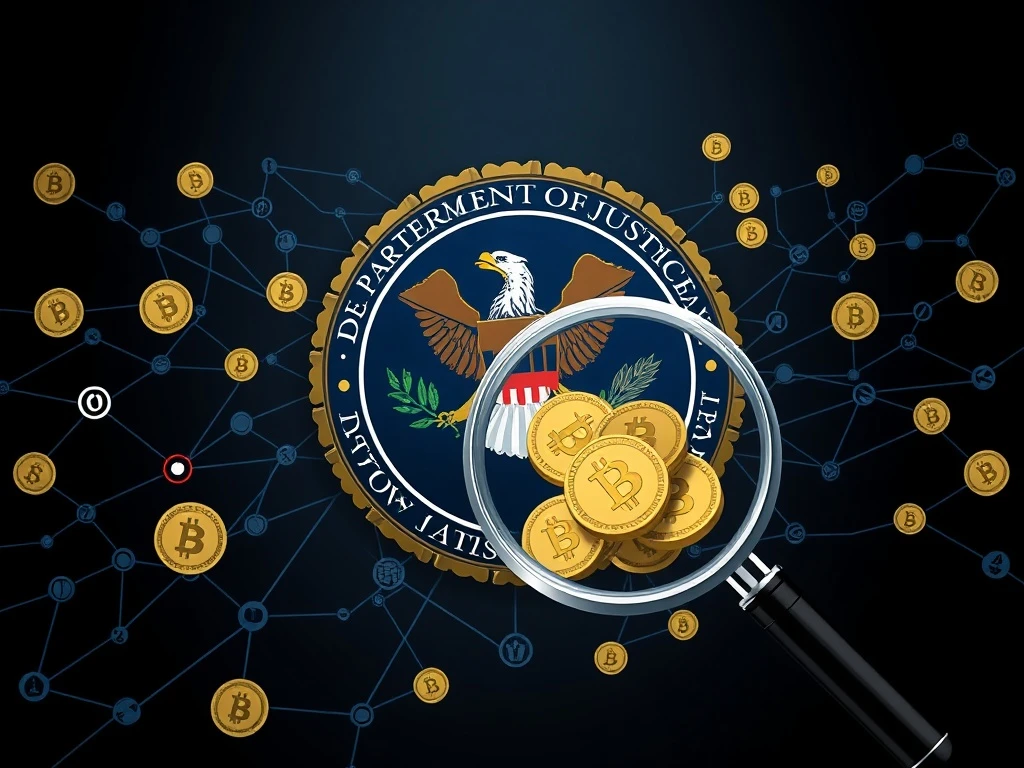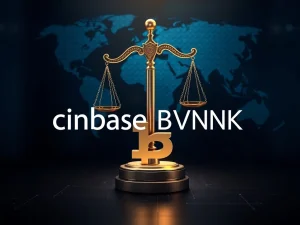Breakthrough Crypto Recovery: DOJ Seizes $40K from Trump-Vance Scam, Thanks to Tether

In a significant win against digital fraudsters, the U.S. Department of Justice (DOJ) recently announced a successful crypto recovery operation, seizing $40,300 in cryptocurrency from an email scam. This particular scheme impersonated officials from the Trump-Vance Inaugural Committee, highlighting the cunning tactics scammers employ. The recovery underscores the growing collaboration between law enforcement and cryptocurrency firms like Tether in the ongoing fight against illicit financial activities in the digital realm. For anyone navigating the world of digital assets, understanding these incidents is crucial for safeguarding your investments.
The Anatomy of a Trump-Vance Scam: How Digital Deception Unfolded
The scam began with a deceptively simple email on December 24, 2024, designed to trick a donor into believing they were contributing to a legitimate political cause. The perpetrators behind this particular Trump-Vance scam leveraged social engineering, a common tactic where fraudsters manipulate individuals into divulging confidential information or performing actions that benefit the scammer.
- Impersonation: The email appeared to originate from Steve Witkoff, co-chair of the Trump-Vance Inaugural Committee, lending an air of authenticity to the fraudulent request.
-
Subtle Deception: A key element of the deception was the email domain itself:
@t47lnaugural.com. This domain cleverly swapped a lowercase “l” for an “i” in “inaugural,” a subtle difference easily overlooked by an unsuspecting recipient. - Fund Transfer: Believing the request was genuine, the victim transferred $250,300 worth of USDt (USDT) stablecoin on the Ethereum blockchain into a crypto wallet controlled by the scammers just two days later. The speed with which these funds were then laundered through multiple cryptocurrency wallets demonstrates the rapid operational pace of such illicit enterprises.
This incident serves as a stark reminder of how sophisticated and targeted these scams can be, often preying on trust and urgency. It’s not just about complex hacks; sometimes, the simplest trick can lead to significant financial loss.
DOJ Crypto Recovery: Tracing the Digital Footprints
Despite the swift movement of the stolen funds, the Federal Bureau of Investigation (FBI) played a pivotal role in the subsequent DOJ crypto recovery. Utilizing advanced blockchain analysis techniques, investigators were able to trace the flow of the stolen USDT. This process is akin to following a digital breadcrumb trail, leveraging the transparent nature of public blockchains to identify the movement of assets, even when they are shuffled through numerous wallets.
Of the initial $250,300 stolen, the FBI successfully traced and recovered $40,300. Federal prosecutors are now pursuing a civil forfeiture action to ensure these recovered assets are returned to the victim. This legal step is crucial for formally seizing the illicitly obtained funds and facilitating their restitution.
Assistant Director in Charge Steven Jensen of the FBI Washington Field Office emphasized the pervasive nature of impersonation scams, which account for billions in losses annually. He issued a strong warning to the public, urging vigilance:
- Scrutinize Email Addresses: Always double-check the sender’s email address for any discrepancies, no matter how minor they seem.
- Verify Requests: Never send cryptocurrency, gift cards, or any other assets to individuals you don’t know personally or have only interacted with online or over the phone. Always verify requests through an independent, trusted channel.
The success of this crypto recovery operation highlights the increasing capabilities of law enforcement to combat digital asset crime, signaling a new era where blockchain transparency aids justice.
Tether’s Crucial Role in USDT Seizure and Beyond
A critical aspect of this recovery was the invaluable assistance provided by Tether, the issuer of the USDT stablecoin. The DOJ specifically credited Tether for its role in helping to freeze and transfer the stolen funds. This collaboration is a testament to the growing partnership between blockchain companies and regulatory bodies in combating financial crime.
Tether’s cooperation in this USDT seizure is not an isolated incident. In June, the federal agency also acknowledged Tether’s significant contribution to seizing approximately $225 million in USDT linked to a massive “pig butchering” scam that defrauded victims across several countries. These sophisticated scams often involve building long-term relationships with victims before convincing them to invest in fraudulent schemes, typically in cryptocurrency.
The willingness of stablecoin issuers like Tether to assist law enforcement is a powerful deterrent against the use of their tokens for illicit purposes. It demonstrates that while cryptocurrencies offer anonymity to a degree, the underlying blockchain technology can often be traced, and cooperation from key industry players can lead to substantial asset seizures and recoveries. This active participation by companies helps to mitigate the perception that cryptocurrencies are solely a haven for illegal activities, strengthening the overall integrity of the digital asset ecosystem.
Protecting Your Digital Assets: Actionable Insights Against Crypto Scams
The rising prevalence of cryptocurrency scams necessitates a proactive approach to security. While law enforcement agencies are improving their capabilities for crypto recovery, prevention remains the best defense. Here are some actionable insights to protect yourself:
- Verify Sender Identities: Always independently verify the identity of anyone requesting funds or sensitive information, especially if the request involves cryptocurrency. Do not rely solely on email or direct messages. Use official phone numbers or established communication channels.
- Beware of Urgency: Scammers often create a sense of urgency to pressure victims into making hasty decisions. Be suspicious of requests that demand immediate action or threaten negative consequences if you delay.
- Understand Blockchain Basics: Familiarize yourself with how cryptocurrencies and blockchains work. Knowledge about transaction finality and wallet addresses can help you identify red flags.
- Use Strong Security Practices: Enable two-factor authentication (2FA) on all your crypto accounts and email. Use unique, complex passwords. Consider hardware wallets for significant holdings.
- Research Before Investing: Before sending funds to any new platform or investment opportunity, conduct thorough research. Check reviews, look for official registrations, and be wary of promises of unusually high returns.
- Report Suspicious Activity: If you encounter a potential scam, report it to the relevant authorities like the FBI (through IC3.gov) or local law enforcement. Your report can help protect others.
Even public figures and their campaigns are not immune to such attacks, as seen with Donald Trump’s presidential campaign accepting cryptocurrency donations through Coinbase Commerce. This move, while expanding fundraising avenues, also highlights the need for heightened security awareness across all sectors dealing with digital assets.
The Evolving Landscape of Crypto Regulation and Enforcement
The successful recovery of funds in the Trump-Vance scam, alongside other high-profile seizures, illustrates a clear trend: the increasing sophistication of law enforcement in tackling crypto-related crime. This collaboration between government agencies and private sector entities like Tether is crucial for building trust and legitimacy in the digital asset space.
The DOJ’s repeated acknowledgement of Tether’s assistance, including in the massive “pig butchering” scam where $225 million in USDT was seized, signals a growing expectation for crypto companies to actively participate in combating illicit finance. This proactive stance helps to shape a regulatory environment that balances innovation with security. As the crypto market matures, we can anticipate more stringent regulations and more effective enforcement mechanisms aimed at protecting consumers and maintaining financial integrity.
The incident also underscores the importance of ongoing education for both individuals and organizations. As crypto adoption expands, so too does the attack surface for scammers. Vigilance, combined with robust security practices and strong inter-agency and industry cooperation, will be essential in navigating the complexities of the digital economy.
Conclusion: A Step Forward for Digital Asset Security
The successful crypto recovery by the DOJ from the Trump-Vance inaugural scam, greatly aided by Tether’s swift action, marks a significant victory in the ongoing battle against digital asset fraud. It demonstrates that even sophisticated scams, leveraging subtle tricks and rapid fund movements, are not beyond the reach of determined law enforcement and cooperative industry partners. This case serves as a powerful reminder of the risks present in the digital asset space, but also of the growing capabilities to mitigate those risks.
As the cryptocurrency ecosystem continues to evolve, the collaborative efforts between government agencies and private blockchain companies will be paramount in fostering a safer and more secure environment for all participants. For individuals, the lesson is clear: remain vigilant, verify everything, and never underestimate the cunning of a scammer. Your digital assets depend on it.







